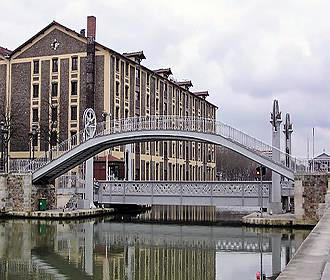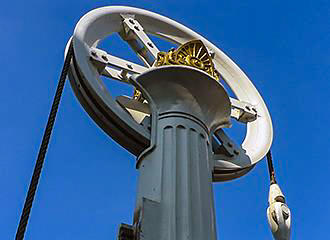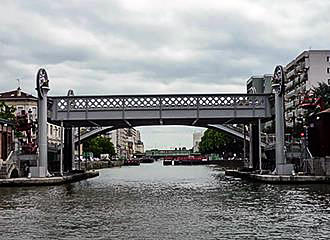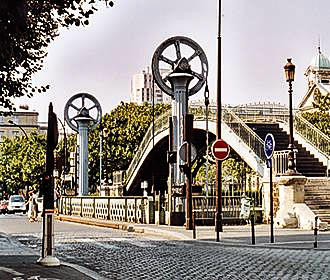Paris Pont Levant de la Rue de Crimee bridge
This was the first ever lift bridge in Paris and only the third to be built in France that was a major engineering feat of its time when it was constructed in 1885, and now classified as a historical monument in Paris, you can find the Paris Pont Levant de la Rue de Crimee bridge going over the Canal de l’Ourcq by the Bassin de la Villette, and still in full operation today, this hydraulic lift bridge still manages around 9000 operations every year.
A bit of history
The Canal de l’Ourcq was constructed during the reign of Napoleon Bonaparte, yet was not finished until after the fall of the empire, and originally there was a wooden bridge put in place in 1808 between the Port de la Villette, which is also known as the Bassin de la Villette, and the start of the canal.
However, this bridge was replaced by a wooden drawbridge, but along with numerous buildings and warehouses, it was burned and destroyed in 1870 during the Paris Commune.
And it was then replaced by a metal swing bridge, but the canal and the port was widened to allow larger cargo vessels to navigate the canal, and a new road was created from one side of the Canal de l’Ourcq to the other called the Rue de Crimee.
So the bridge was replaced with a lift bridge, which was designed by Felix Eugene Edmond Humblot along with the engineer L le Chatelier and it was inaugurated in the August of 1885 with a full name of Pont Levant de la Rue de Crimee.
About the Paris Pont Levant de la Rue de Crimee bridge
Now, the Paris Pont Levant de la Rue de Crimee bridge is a hydraulic lift bridge that had its workings hidden within the sewers and utilised the pressurised water from the canal in order to make its lift and descent, which allowed passage for steamers and other canal barges on the waterway.
This lift bridge has been working continuously from 1885, and was classified as an historical Paris monument by formal decree in 1993, however by 2010, being the only remaining lift bridge in Paris, it was showing major signs of wear and tear and needed to be closed temporarily for several repairs, including to make it more economical and safer to operate.
Due to corrosion, the steel deck was replaced, the moving parts including the lift mechanism were completely overhauled and refurbished, and the hydraulic system located in the sewers was modernised, so that it did not need to rely on the water system for its operation.
In fact, the Paris Pont Levant de la Rue de Crimee bridge is now controlled remotely from the control room at the Ecluse du Pont de Flandre, which is the first lock on the Canal Saint-Denis.
Even though the Paris Pont Levant de la Rue de Crimee bridge has been modernised and there are automatic barriers that go down on the road either side when the bridge is required to lift, you can still get to see the original working parts including the wheels where the cables go round to support the bridge when it has been lifted.
You will find that the length of time the Paris Pont Levant de la Rue de Crimee stays up does depend upon what needs to pass between the Bassin de la Villette and the Canal de l’Ourcq, yet there is now a footbridge next to this, so that pedestrians can still get from one side to the other without having to wait.
Although, this fascinating and unique bit of history in Paris is well worth seeing in operation, which happens approximately 9000 times per year, and you can also get to see this if you are on one of the canal cruises with companies such as Canauxrama or Paris Canal, who also provide cruises on the Canal Saint-Martin, etc.
Visiting the Paris Pont Levant de la Rue de Crimee bridge
Sometimes still referred to as just the Pont de Crimee, this bridge takes its name from the road that travels over the Canal de l’Ourcq at the intersection with the Bassin de la Villette in the 19th Arrondissement.
You will find that the Paris Pont Levant de la Rue de Crimee goes from the Quai de l’Oise to the Quai de la Marne, and the nearest Metro stations are the Crimee and Riquet stops serving line 7 on one side, along with the Ourcq and Laumiere stops serving line 5 on the opposite side or the canal.
However, the Paris bus lines 54 and 60 along with the Noctilien Line N42, which is the Night Bus Service that runs when the day time buses and the Metro have stopped working for the early hours, and these lines are the closest to this historical bridge in Paris.



